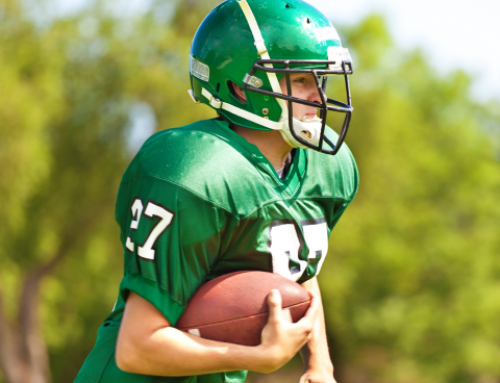3 Common Causes of Weight Room Chest Pain
Chest pain is a symptom of an intense cardio workout. It can also interrupt your weight room training, in which case it’s a lot scarier than a pounding heartbeat during a sprint. Imagine going up for a lift and crumbling down from a sharp stinger in your chest.
Avoid chest pain by understanding the mechanisms in play. This will help you prevent the aggravation of a potential injury and possibly any risks to your health. (See also Weightlifting Guidelines Every Athlete Should Remember.)
First and foremost, prior to engaging in a fitness or strength and conditioning program, athletes must be aware of their family history and current state of cardiovascular health.
Three factors can cause weight room chest pain: fatigue, injury and coronary heart disease.
Fatigue
This is the most common culprit contributing to chest pain. It usually stems from local fatigue in the sternal and clavicular heads of the pectorals major, pectorals minor, anterior deltoids, or coracobrachialis, and the internal rotators of the shoulder.
A strenuous workout can induce this type of fatigue. Training in a dehydrated, malnourished state can aggravate it. To avoid experiencing chest pain due to fatigue, incorporate gradual increases in loads, sets and reps. This will not only mitigate against fatigue but greatly reduce your potential for injury. (See How to Judge the Seriousness of Pain During a Workout.)
Injury
Typically in the form of a strain or rupture, injury is another common source of chest pain.
Injuries can occur when the muscles aren’t properly warmed up or grow tired as the exercise or workout wears on. Strains and ruptures can happen during the execution of pressing exercises, because the stabilizing forces provided by the muscles of the upper back cannot overcome the strong inward pull of the pectorals on the shoulders. When this happens, especially while you are gripping a heavy object, the fibers of the pectorals nestled deep in the shoulder may be damaged. If you hear a popping sound emanating from your shoulder during a movement, or experience a painful grinding sensation when crossing your arm in front of your body, your pecs may have ruptured or torn.
If you suspect an injury, stop working out immediately. Consult an orthopedic physician to receive a definitive diagnosis and subsequent treatment.
Tips to prevent chest injuries
- Prior to lifting, perform a thorough warm up, including mobility and activation drills.
- Strengthen the muscles of your back and rotator cuff.
Coronary Heart Disease
Although CHD is a less common cause, it constitutes the greatest health risk if disregarded. Events related to CHD are different from those stemming from fatigue and injury. Symptoms include:
- Chest pain accompanied by numbness and tingling sensations radiating into the arms and along the neck and jaw
- Sudden chest pain with shortness of breath and/or nausea
- Light headedness
- Extreme fatigue
- Fainting
If you suspect a complication arising from CHD, cease training and seek immediate medical attention.
RECOMMENDED FOR YOU
MOST POPULAR
3 Common Causes of Weight Room Chest Pain
Chest pain is a symptom of an intense cardio workout. It can also interrupt your weight room training, in which case it’s a lot scarier than a pounding heartbeat during a sprint. Imagine going up for a lift and crumbling down from a sharp stinger in your chest.
Avoid chest pain by understanding the mechanisms in play. This will help you prevent the aggravation of a potential injury and possibly any risks to your health. (See also Weightlifting Guidelines Every Athlete Should Remember.)
First and foremost, prior to engaging in a fitness or strength and conditioning program, athletes must be aware of their family history and current state of cardiovascular health.
Three factors can cause weight room chest pain: fatigue, injury and coronary heart disease.
Fatigue
This is the most common culprit contributing to chest pain. It usually stems from local fatigue in the sternal and clavicular heads of the pectorals major, pectorals minor, anterior deltoids, or coracobrachialis, and the internal rotators of the shoulder.
A strenuous workout can induce this type of fatigue. Training in a dehydrated, malnourished state can aggravate it. To avoid experiencing chest pain due to fatigue, incorporate gradual increases in loads, sets and reps. This will not only mitigate against fatigue but greatly reduce your potential for injury. (See How to Judge the Seriousness of Pain During a Workout.)
Injury
Typically in the form of a strain or rupture, injury is another common source of chest pain.
Injuries can occur when the muscles aren’t properly warmed up or grow tired as the exercise or workout wears on. Strains and ruptures can happen during the execution of pressing exercises, because the stabilizing forces provided by the muscles of the upper back cannot overcome the strong inward pull of the pectorals on the shoulders. When this happens, especially while you are gripping a heavy object, the fibers of the pectorals nestled deep in the shoulder may be damaged. If you hear a popping sound emanating from your shoulder during a movement, or experience a painful grinding sensation when crossing your arm in front of your body, your pecs may have ruptured or torn.
If you suspect an injury, stop working out immediately. Consult an orthopedic physician to receive a definitive diagnosis and subsequent treatment.
Tips to prevent chest injuries
- Prior to lifting, perform a thorough warm up, including mobility and activation drills.
- Strengthen the muscles of your back and rotator cuff.
Coronary Heart Disease
Although CHD is a less common cause, it constitutes the greatest health risk if disregarded. Events related to CHD are different from those stemming from fatigue and injury. Symptoms include:
- Chest pain accompanied by numbness and tingling sensations radiating into the arms and along the neck and jaw
- Sudden chest pain with shortness of breath and/or nausea
- Light headedness
- Extreme fatigue
- Fainting
If you suspect a complication arising from CHD, cease training and seek immediate medical attention.











